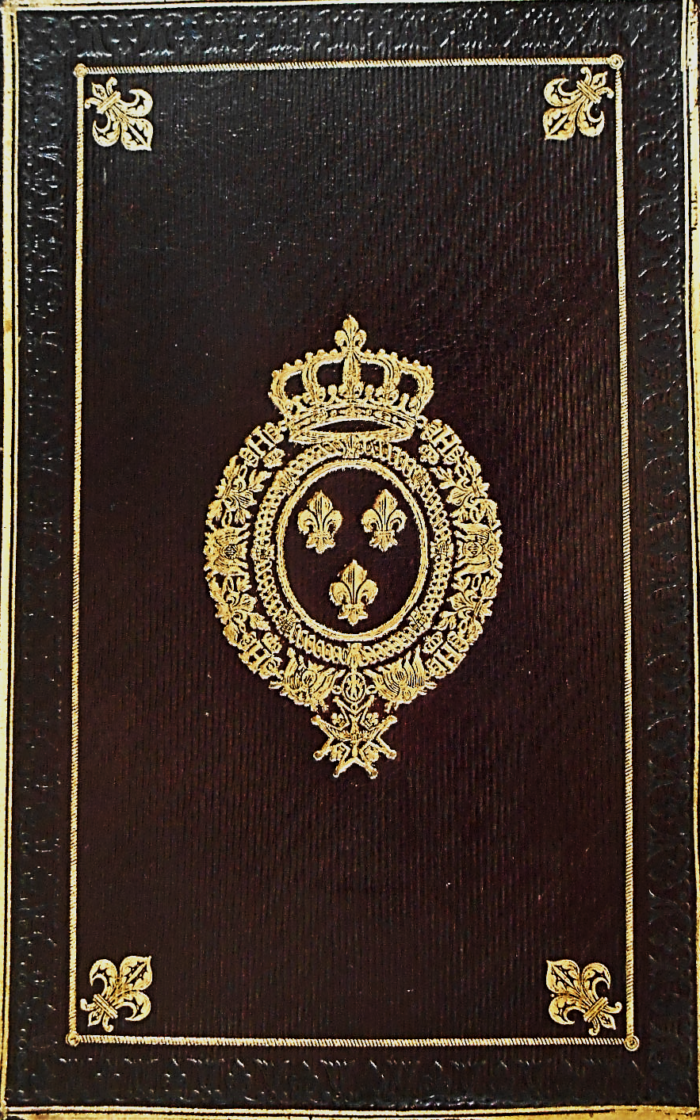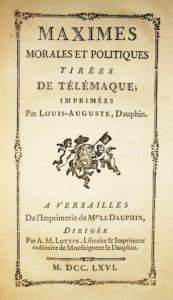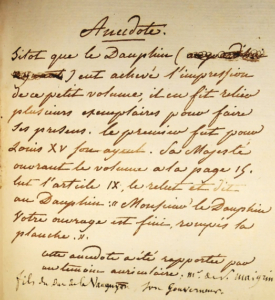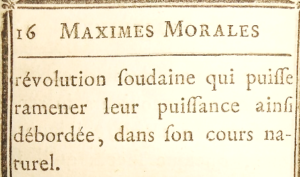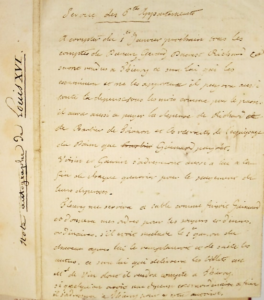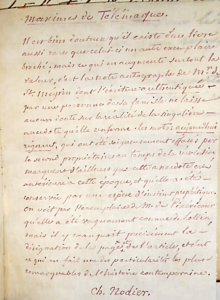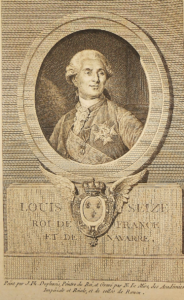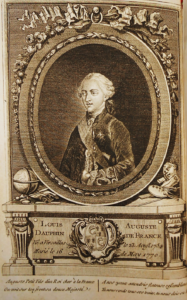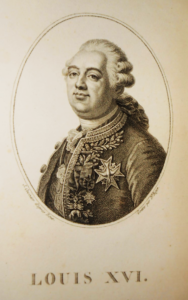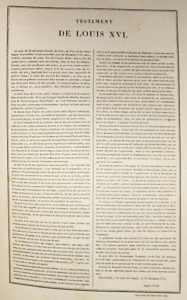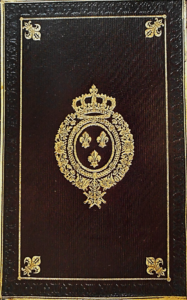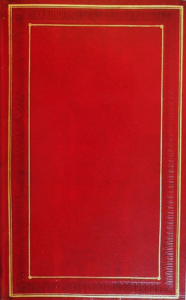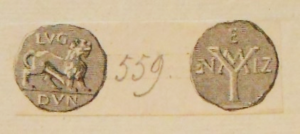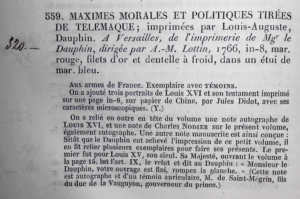Louis XVI. Maximes morales et politiques tirées de Télémaque ; imprimées par Louis-Auguste, Dauphin. Versailles, De l’Imprimerie de Mgr le Dauphin, dirigée par A. M. Lottin, Libraire & Imprimeur ordinaire de Monseigneur le Dauphin, 1766. In-8°. Wood with the arms of the Dauphin in the title, headband, title and framed text. Long-grained red morocco, richly decorated flat spines, gilt title, framed with gilt fillets and a large cold roulette, gilt stippling on the edges, gilt stippling and fillet on the endpapers, peach tabis endpapers, in a slipcase in the shape of an in-8° volume, in long-grained dark purple morocco, double gilt fillets and title on the spine, edges adorned with a gilt roulette of stars, framed on the boards with a double gilt fillet, a large cold lace of lilies and a gilt roulette with fleur-de-lys in spandrels, coat of arms of Louis XVI in the centre of the covers, large mauve ribbon used as a drawstring on the back cover.
This is a rare first edition, with only 25 copies printed by the royal press at the Château de Versailles. The work was republished in 1799 under the title Maximes morales et politiques tirées de Télémaque, imprimées par Louis Auguste, Dauphin, depuis Louis XVI roi de France, then by Royer in 1814 and by Didot in 1815.
As part of his studies, the Dauphin had written 26 maxims on the duties of a king, inspired by Fénelon’s Aventures de Télémaque. La Vauguyon, his governor, was pleased with his royal pupil’s work and took advantage of the fact that Lottin, the Dauphin’s printer since 30 December 1765, had been teaching Louis-Auguste typography from 9 to 21 March 1766, to have 25 copies printed by his hand and offer one to the king.
The bookseller and publisher Pierre Châteauneuf describes the circumstances surrounding this printing: “This small edition was produced in the flat of Monseigneur le Dauphin himself, under the direction of A. M. Lottin, his bookseller and ordinary printer. Louis XVI was twelve years old at the time, the Count of Provence eleven, the Count of Artois nine; these three Princes were present during the typographical operations; Monseigneur le Dauphin printed all the copies himself, amounting to twenty-five.“ (Bulletin du Bibliophile belge, Bruxelles, 1856, tome XII, p. 26-27).
These 25 copies, printed, according to Quérard, “for the court only“, were intended as a gift for Louis-Auguste. Ours comes from the library of Charles Nodier. It was sold at auction in 1829, in its morocco case, No. 120 in the sale. Nodier thought that the Dauphin had kept it for his personal use, as he wrote in his Mélanges tirés d’une petite bibliothèque, chapter VIII, p 97 ff : “The simplicity of the condition of this one indicates that it was intended to remain in the cabinet of its illustrious author, and it is probable that one would not find another one in all its margins; but this particularity would not have been enough to give it here a place that too many other precious books claimed for the same reason. Here is the feature that distinguishes it, in my opinion, in such a way as to rank it among the rarest curiosities in my library. On the front of the frontispiece is the following note : Anecdote. This is the famous autograph “Anecdote” of “M. de S[aint]-Maigrin fils du Duc de la Vauguyon“, Governor of the Dauphin, about this work, well bound in our copy. 1 p. in-12.
“As soon as the Dauphin ([now reigning cancelled]) had finished printing this little volume, he had several copies bound for his presents. The first was for Louis XV, his grandfather. His Majesty opened the volume on page 15, read article IX, reread it and said to the Dauphin: “Monsieur le Dauphin, your work is finished, break the plate”. This anecdote was reported by an ear witness”. Here is this article IX : “When Kings have once broken the barrier of good faith & honour, they can no longer restore the confidence which is so necessary to them, nor bring back to the principles of virtue & justice the men whom they have taught to despise them; they become Tyrants, their Subjects rebels, & there is only a sudden revolution which can bring their power thus overrun, back into its course.”
This is followed by a brilliant and moving commentary by Nodier on this “prophesied revolution”: “Here reflections crowd in, and one hardly dares to collect them. One cannot help thinking that it was Louis XVI who chose this maxim, that it was Louis XVI’s hand that printed it, that it was Louis XV who appreciated its significance with such bitter energy; for make no mistake, these astonishing words: ‘Your work is finished, break the board’, cannot relate to the mechanical work of printing. The printing had been completed; the Dauphin had had several copies bound; the plate had been broken. This can only be seen as a threatening allusion, a kind of prophetic allegory of the coming revolution, about which everyone knows that the mind of Louis XV was deeply preoccupied.
The copy also contains other valuable documents:
- An autograph note from Louis XVI, no place or date [1782?]. 1 p. ¼ in-16. Interesting document concerning the daily service of the Grands Appartements at Versailles. In it, the monarch specifies the prerogatives of Marc-Antoine Thierry, Baron de Ville-d’Avray (1732 – massacred in 1792 in the Abbaye prison), the King’s first valet de chambre. In 1782 he was appointed superintendent of small cabinets. Louis XVI also set the rules for table service.
« Service des C[omp]tes Appartements. From 1 January next all the accounts of Dunan [?], Geraud, Daivest [?], Richard etc. will be returned to Thierry, who will examine them and bring them to me; he will also pay all the expenses every month as in the past. He will also have to pay the expenses of Richard and Barbier de Trianon and the retreats of the crew of the Daim that [Barbier cancelled] Guimard paid. Voisin and Gauvin will also apply to him at the end of each quarter to pay their expenses. Fleury will serve me at table as Guimard did and will give my orders for the ordinary suppers and dinners. If he is ill, the 1st waiter of the castle after him will replace him and then the others. He will issue the tickets to the M[archan]d de Vin and will report to Thierry. If anyone has any extraordinary expenditure to make, he will apply to Thierry for authorisation. As in the past, Burey will continue to be responsible for all matters relating to workers and cleaning. He will also keep the key to the cellar where the liqueur wines and my ordinary wine are kept, for which he will report to Thierry.. »
- A signed autograph commentary by Charles Nodier on the exceptional value of the copy. 1 p. in-16 in red ink.
« Maximes de Télémaque. It is doubtful that there is another paperback copy of a book as rare as this one; but what increases its value above all is the autograph note by Mr de St. Mégrin, whose handwriting, authenticated by a member of his family, leaves no doubt as to the reality of the singular anecdote it contains. The words: “today reigning”, which were carefully erased by the second owner at the time of the revolution, show moreover that this anecdote predates that time, and that it was preserved by a kind of prophetic instinct. We can see from M. de Pixérecour’s copy that it was vaguely known to Lottin, but it lacked precisely the designation of the page and the article, and this is what makes it one of the most remarkable peculiarities of contemporary history. Ch. Nodier».
- 3 engraved portraits of Louis XVI. Louis Seize by Le Mire after J. Ph. Duplessis, followed by Louis Auguste Dauphin de France, engraved around 1770, at the time of his marriage (16 May), placed in the frontispiece, and in fine, Louis XVI lithographed by Roger after J. Croizier after Boze.
- The Testament de Louis XVI. A very rare two-column, one-page printing on Chine, produced in 1823 by Jules Didot aîné, with its “microscopic” characters.
« It was at the age of sixty,” reports Alkan, “when engravers are usually occupied only with large type, or can do nothing more for the art, that M. Vibert ended his typographical career by undertaking, for M. Jules Didot, the engraving of a very small typeface, a true masterpiece: the son of Pierre Didot the elder printed the Testament of Louis XVI with this three and a half. These same types were also used to print the entire Belgian Constitutional Charter. This microscopic typeface, which can also be called ophthalmic, because of its extreme smallness that tires the eye, is admirably regular. » (Alkan l’aîné, « Nécrologie : Vibert (Jean) », Feuilleton du Journal de la librairie, 13 janvier 1844, p. 7-8).
History of the copy. Charles Nodier, in his Mélanges, mentions a previous owner: “The person who preceded me in the possession of this book managed to ascertain that the ear witness referred to in the note is M. de Saint-Mégrin […]”; the copy was in modest condition, “in all its margins”. Nodier specifies that there was a frontispiece, as well as Saint-Mégrin’s autograph note. Aware of the rarity of the copy, he probably had the precious book case made in dark violet, the colour of mourning, with the arms of Louis XVI, and inserted his autograph note in red ink.
Sold at auction in 1830, bound in half red morocco, it then came into the possession of the great bibliophile Nicolas Yemeniz, who probably had it magnificently bound in full red morocco, enriching it with 2 portraits, the autograph note of Louis XVI and the Testament of Louis XVI, while inevitably trimming its margins.
Provenance: Charles Nodier, sale January 1830, catalogue no. 120; former Yemeniz collection, with his bookplate, sale May 1867, no. 559, sold for the hefty sum of 320 fr. or.
Peignot, Répertoire de bibliographies spéciales, curieuses et instructives, 82 ; Brunet, II, 1218-1219 ; Quérard, La France littéraire, V, 367 ; Paul Dupont quotes the edition in his « Tableau chronologique des principaux faits qui se rattachent à l’histoire de l’imprimerie depuis son origine jusqu’à nos jours ». (Chronologie de l’histoire de l’imprimerie, 1853). For the arms of Louis XVI, O.H.R., very slight variant of tool no. 7 on plate 2496.
Some minor rubbing to the binding of the book due to the slipcase, some very slight traces of wear to the slipcase, renewed ribbon.
An exceptional copy.
30 000 €
